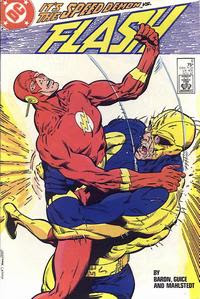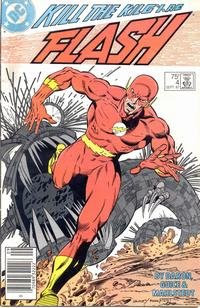 Writers: John Ostrander & Len Wein
Writers: John Ostrander & Len Wein
Artists: John Byrne & Karl KeselSince
the second Flash series "spun out" of
Legends, I thought it would be interesting to take a closer look at it. I'm glad I did! A lot of my recent theoretical/critical musings on DC comics have been based on half-remembered comics read long ago, so I'm never quite sure how well they'll stand up when tested against the thing itself. For example, I was looking for evidence of the
benefits of writing Mythos-centric super-hero comics, but, so far, the Baron/Guice run on
Flash has mostly shown the
costs of this kind of writing.
So, on an admittedly self-centered level, I find
Legends interesting because it confirms some of my ideas about the way DC's different "ages" break down in terms of (a) the relationship of the Mythos to the World and (b) the amount of self-reflexivity in the writing.
We open on Apokolips, with some pitch-perfect caption writing from Len Wein:
"Here, where even miles-high columns of flame spewed ceaselessly by awesome energy-pits fail to penetrate the eternal darkness, joy is unknown and hope is a capital offense..."
Hey - here's another theory:
There are a couple of what I'd call "Fault Line Questions" that creators (meaning writers, artists, and editorial) need to deal with when they're mucking around with the DC Mythos. These are questions that cry out to be answered, but attempts to answer them definitively usually end up creating some kind of rupture in the Mythos, which then needs to be addressed in turn, leading to a cycle of Perpetual Crises.
Maybe the biggest Fault Line Questions is "What do we do with Superman?" But coming in second is probably "What do we do with the Fourth World?"
I don't want to characterize the Fourth World as "Kirby's Last Gasp" (I think his work throughout the 9170s was pretty strong), but it was his last (or, arguably, only) chance of creating an entire "Universe" of his own. Unlike the DCU proper, which was made up of bits and pieces foraged from various Golden Age comics, the Fourth World was a coherent creation of a singular artistic vision - one of the strongest, and most singular in all of comics (and not just super-hero comics). And it also represents one of the last major "explosions" of creativity in mainstream super-hero comics (in order: the initial Golden Age boom, Julie Schwartz's Silver Age refurbishments, the Stan Lee et al.'s Marvel Age, and, finally, the Fourth World).
So, on the one hand, you've got this incredibly rich and evocative cast of characters and series of storylines. So rich and so evocative that they form the core of one of
the major pop culture events of the last forty years. On the other hand, the Fourth World is palpably its
own thing, or rather, Kirby's own thing. It is not quite compatible with the DCU, even though Kirby's attempt to make it so are among his most interesting comics.
With
Legends, DC was trying to set up some overarching storylines and themes for a post-
Crisis DCU and, following
The Great Darkness Saga, they pick Darkseid to be the new Big Bad. Early into the first issue, he gives us a Title for the series and its Argument. Ranting about those accursed super-heroes of Earth, he says:
"To some these puny creatures are legends, the stories of their greatness inspiring others to greatness as well! Perhaps the time has come to strike at the core of the problem -- to destroy the very concept of such legends!"
So begins Operation Humiliation!
A quick comics-in-the-good-old-days note: Ostrander, Wein, and Byrne pull off some economical storytelling here. We get a quick set-up and then jump right into the action.
From a
Flash-project p.o.v., it's interesting to see that a lot of the themes Baron has to work with are set up here. (How does that bear on the issues being discussed
in these comments?)
We're also introduced to Glorious Godfrey, who has come to Earth in the disguise of media pundit G. Gordon Godfrey, speaking out against super-heroes. Anti-super hero punditry isn't a new development (see J. Jonah Jameson), but I get the sense that this particular incarnation is very much inspired by Frank Miller's
Dark Knight Returns, which finished up a few months before
Legends began.
The first issue ends with something that I had forgotten, but was like "Oh, yeah - I remember
that!" after I re-read it. Captain Marvel is caught in the grip of a giant Kirby-lite villain called Macro-Man (John Byrne has drawn him so he looks like a midget Galactus). To escape, Cap yells "Shazam!", thinking that as Billy Batson he'll be able to wriggle free. But, alas, the magic lightning bolt
fries Macro-Man to death! Guilt stricken, Billy vows never to become Captain Marvel again.
Though this sounds grim, surprisingly enough it's a pretty effective moment. Unfortunately, just around the corner in
Legends, we'll get some narrative weaseling that will completely undermine any impact this had. (On second thought, James,
maybe you're right!)








